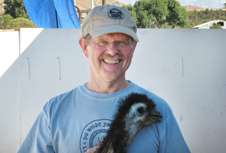Lessons on bird-watching

What do emus, ostriches, and humans have in common? Similar walking and running mechanics and the ability to use energy efficiently, according to a new study coauthored by Northeastern University researcher Richard Marsh.
The study links the muscle function of animals limbs with corresponding energy use, which Marsh said could spark breakthroughs in the development of rehabilitation devices for humans.
Researchers found emus and ostriches prefer to walk within a narrow range of economical speeds—a trend that continues even when they switch to running. Marsh said that despite anatomical differences, humans follow the same pattern. Therefore, the basic findings from studying the biomechanics of these large birds can provide crucial information for developing the next generation of prosthetic legs and ankles.
Marsh, a biology professor in the College of Science, said the goal is to “unite human and animal studies in terms of limb mechanics and energetics”—research, he said, that has been oversimplified in the past.
He collaborated with researchers from California State Polytechnic Institute at Pomona on the paper, which was published this month in Proceedings of the Royal Society B, a biological sciences research journal. The report stems from a larger research project funded by the National Science Foundation. Matthew Propert, one of Marsh’s former undergraduate biology students, also contributed to the findings.
Marsh said the research could lead to other significant applications across a variety of disciplines, including archeology, for example. Understanding muscle mechanics and energy use of emus, ostriches, and other large birds, Marsh said, can even shed light on how extinct animals like dinosaurs once moved.
“What I always tell beginning students to the lab is that if we don’t understand the normal function of the limb, we can’t really hope to optimize rehabilitation strategies and fix problems,” Marsh said.
Provided by Northeastern University

















